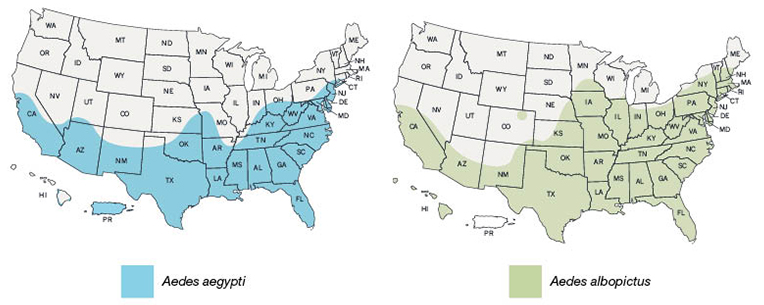Predicting mosquito abundance: Is it possible?
Mosquito prediction would seem to be fairly easy. But as any entomologist and mosquito management practitioner understands, the complexity of environmental conditions can push even the best pest management professionals (PMPs) into being a “soothsayer” — the last label any of us wants to be tagged with. However, our science is progressing at a very fast rate to uncover not only the biology, but the abiotic influences that drive mosquito abundance. Meteorological data such as precipitation, temperature, soils, vegetation, topography and hydrological cycles (to name a few) all play a major role in the rise and fall of the mosquito biological cycles.
One factor our science has a good grip on is species range. Monitoring of species and abundance has become a critical part of mosquito management, and one need only look at species range charts to see native, expanding, receding or invasive ranges of studied organisms. The U.S. Centers for Disease Control and Prevention (CDC) has these charts for those mosquitoes relative to vectoring human disease as well as research papers that help them predict mosquito abundance.

The past sometimes is a good indication of what the future will bring. These maps show where the Aedes aegypti and A. albopictus mosquitoes are or have been found in the U.S., and estimate their range in 2016.
Source: U.S. Centers for Disease Control and Prevention
One such paper describes “Using a Dynamic Hydrology Model to Predict Mosquito Abundances in Flood and Swamp Water.” It’s a comprehensive look at predicting mosquito abundance in flood plain and swamp conditions. While it does not account for the human factor for the container-breeding mosquitos we encounter, it is a head start for the design of future models that may help us manage those species, too.
Obviously, pulling together all the abiotic, biological and disease prevalence data is necessary to make good decisions for predicting management needs. For now, we must rely on the methodology we currently have, but a new future, based on solid science, is just around the corner.
Mosquito management pro tips
 Pamela Blauvelt, Griffin Pest Solutions, Kalamazoo, Mich.:
Pamela Blauvelt, Griffin Pest Solutions, Kalamazoo, Mich.:
The timing is right for mosquito services right now, because the public sees mosquitoes not only as a disease threat, but a threat to also enjoying their backyards.
 Michael Tulp, Adam’s Pest Control, Port St. Lucie, Fla.:
Michael Tulp, Adam’s Pest Control, Port St. Lucie, Fla.:
If you’re going to get into mosquito work, do your homework and take it seriously. You can’t just slap a mosquito sign on the side of the truck. You’ve got to train, and you’ve got to train, and you’ve got to train.
 David Bisaillon, Envirocare Pest Control, Watertown, Conn.:
David Bisaillon, Envirocare Pest Control, Watertown, Conn.:
Mosquito technicians need to be physically fit and pay attention to detail. He or she is going to be wearing a 40-lb. backpack and doing eight to 10 stops in 90°F heat. We supply water, and send reminder text messages: “Are you drinking water?” We emphasize that drinking soda does not count.
 Jeff Annis, Advanced Services, Augusta, Ga.:
Jeff Annis, Advanced Services, Augusta, Ga.:
We train a lot about droplet size and how to control drift.
We ban using the machine if the wind is noticeable at all. We also don’t spray anything on flowering plants that are obviously used by pollinators. We note this on the work order when we adjust our treatment methods, so the customer knows we are looking to control drift or protect pollinators.
 Bo Thomas, ACE, Advanced Services, Augusta, Ga.:
Bo Thomas, ACE, Advanced Services, Augusta, Ga.:
We have an in-house creative team that does our commercials, and you can see their work on YouTube at “TeamBugStoppers.”
One that got a lot of attention showed kids turning into zombies upon being bitten by mosquitoes. We scheduled the ad to play during episodes of “The Walking Dead,” since we figured they’d be the least offended by the concept. It’s been a big hit — and brought in business.
 Charles Obsorne, ACE, Osborne Pest Management Ltd., Colorado Springs, Colo,.:
Charles Obsorne, ACE, Osborne Pest Management Ltd., Colorado Springs, Colo,.:
Customers have to realize that no matter what you do, they can and will encounter mosquitoes. These are flying insects. We can reduce mosquito populations, but we’re not pied pipers. The average consumer is more educated and understands this, thank goodness, but communication is the biggest thing.
 Ravi Sachdeva, American Pest Management, Olathe, Kan.:
Ravi Sachdeva, American Pest Management, Olathe, Kan.:
I have trained one of my customer service representatives (CSRs) to answer any mosquito-specific customer questions and concerns. She has the ability to priority-schedule mosquito treatments with up to five technicians.
 Mike Tullos, Cramer Pest Control, Charlotte, N.C.:
Mike Tullos, Cramer Pest Control, Charlotte, N.C.:
Each of our technicians is trained in mosquito services, but we often set up full days where we send one tech out to service only mosquitoes that day.
 Bert Putterman, Rentokil North America:
Bert Putterman, Rentokil North America:
We emphasize source reduction, sanitation and exclusion as critical issues in effective mosquito control. Eliminate standing water and breeding sites where possible; cut away grasses and excess foliage; larvicide under ground cover; and make sure window and door screens are effectively tight. If you do this effectively, you will reduce populations immensely.
 Brian Garrison, Mosquito Joe:
Brian Garrison, Mosquito Joe:
There are mosquitoes out west, and the basic approach is not much different from that in eastern regions: You eliminate the breeding sites, treat the sites you can’t eliminate, and treat the resting/loafing areas.
Leave A Comment